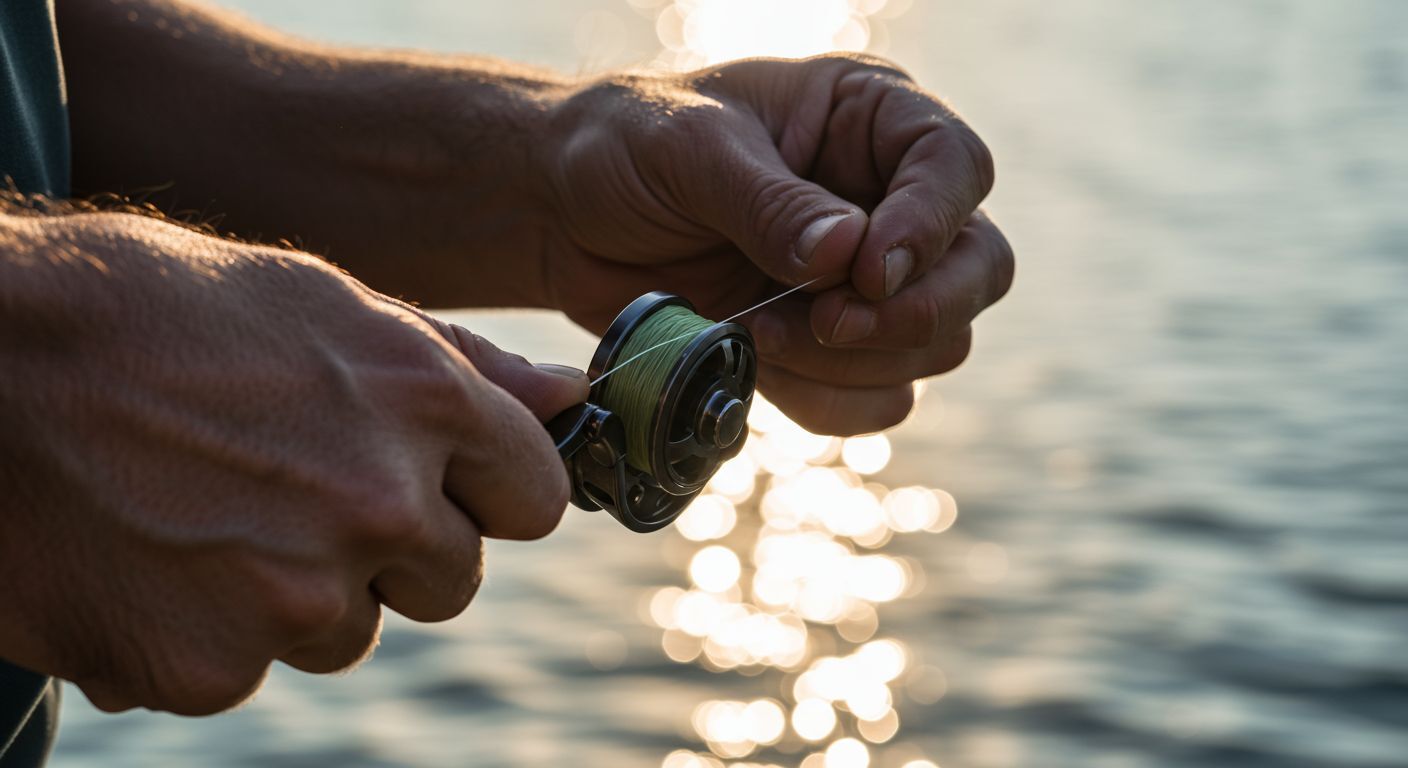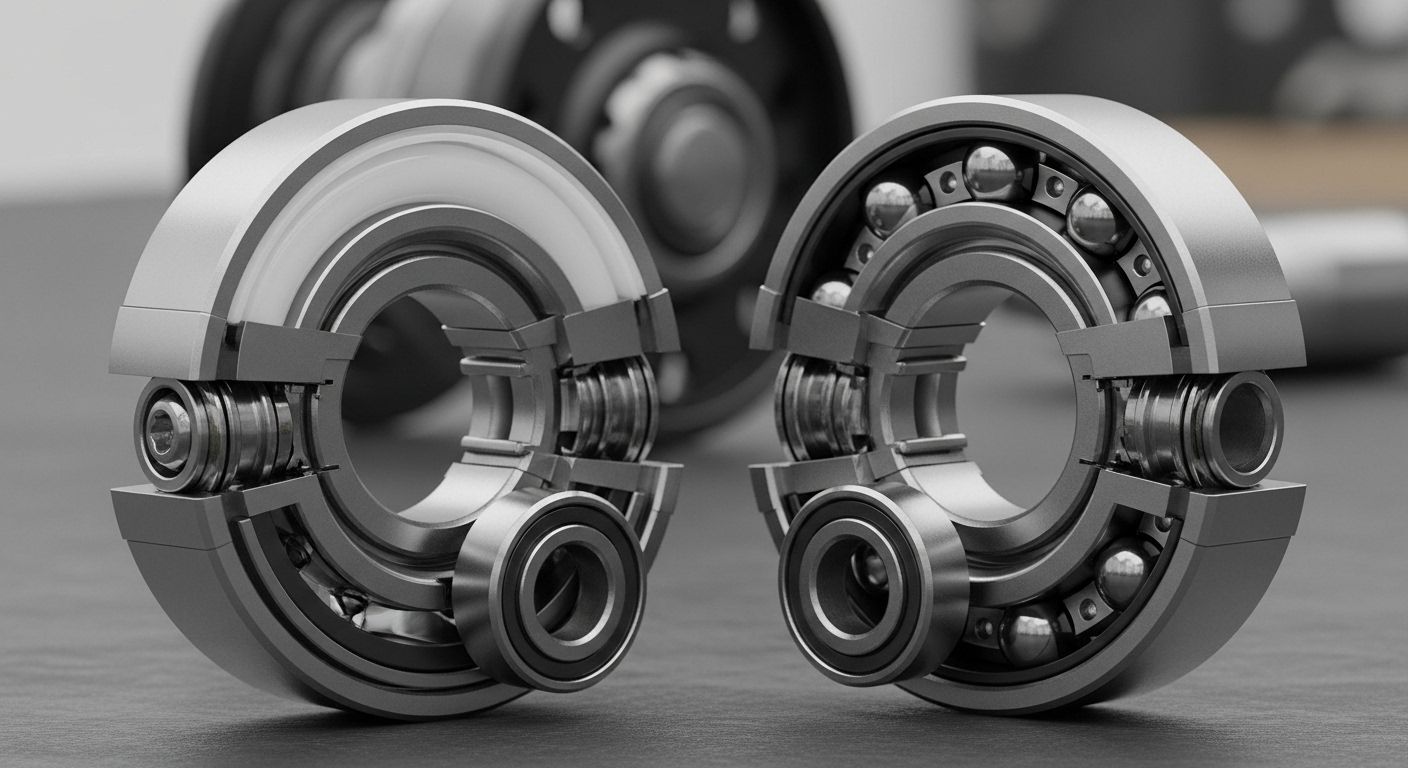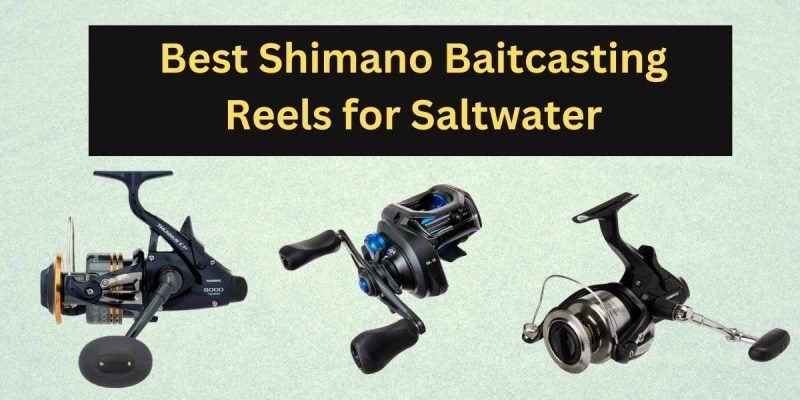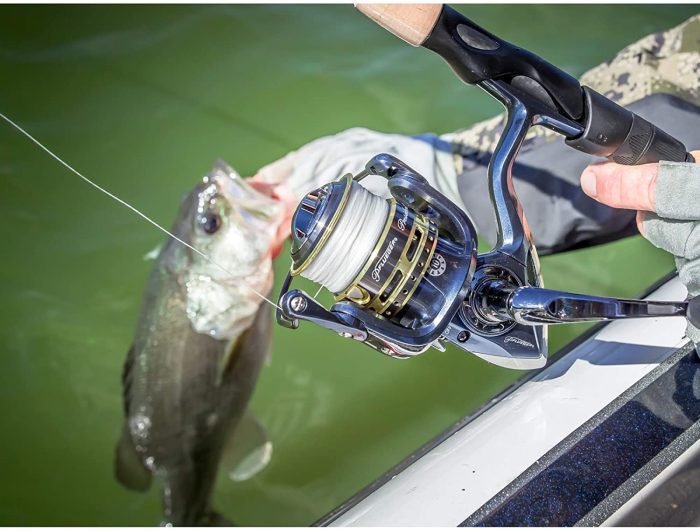I’ve watched countless anglers blame their rods, lures, or even the fish when their day goes sideways on the water. But here’s the hard truth most don’t want to hear: about 80% of fishing frustrations start with improperly spooled reels. It’s the fishing fundamental nobody talks about enough.
After spending two decades teaching fishing workshops, I’ve seen every spooling disaster imaginable. Whether you’re re-spooling a fishing reel that’s seen better days or spooling a new fishing reel fresh out of the box, the process demands more attention than most anglers give it.
Let’s cut through the confusion and master this essential skill once and for all.
Understanding Different Reel Types and Their Spooling Requirements

Each reel type demands specific spooling techniques—there’s no one-size-fits-all approach here. Let’s break down the major players:
Spinning Reels: The Most Misunderstood
Spinning reels might be the most popular choice for anglers, but they’re also the most commonly misspooled. The critical factor most people miss? Line orientation.
Monofilament and fluorocarbon lines have what we call “memory”—they retain the curve from their original factory spool. This memory means your line must be spooled onto your reel in a way that matches this natural curve, or you’re setting yourself up for disaster.
Here’s my foolproof method for spooling a spinning reel:
- Place your filler spool flat on the ground with the label facing up (this matters more than you think).
- Run the line through your rod guides and tie it to the arbor using an arbor knot or uni-knot.
- After turning the reel handle five or six times while maintaining slight tension between your fingers, check the line.
- If you see loose natural curls, you’re good. If you see twists, flip the spool over so the label faces down and try again.
This simple adjustment ensures the line comes off in the proper direction, preventing twisted line before you even hit the water—a gamechanger for your casting distance and accuracy.
Baitcasting Reels: A Different Beast Entirely
The process of spooling a baitcasting reel differs significantly from spinning reels. When spooling fishing line on a baitcasting reel, follow these steps:
- Feed your line through the line guide and out the side plate.
- Tie your preferred knot directly to the spool—I personally prefer the improved clinch knot here.
- Replace the spool while ensuring the line isn’t caught around any mechanisms.
- Reel in your desired amount of line while maintaining consistent tension.
Some baitcasters feature holes in the spool, which offer an alternative method. Feed the line through the guide, place it through one of the holes, reel until the line makes it around the spool, then remove from the hole and tie your knot.
I’ve found that a fishing reel spooling tool can be extremely helpful with baitcasters, providing the perfect tension as you wind. It’s worth the investment if you’re serious about your fishing.
Spincast Reels: The Often Overlooked Category
Spincast reels require removing the front cone before spooling—a step many novices miss. After threading your new line through the first guide of the rod and the front cone, you’ll need to tie a specific knot sequence.
For spincast reels, I recommend:
- Tie an overhand knot
- Wrap around the spool
- Tie another overhand knot with specific placement to ensure the first knot slides underneath and secures the line
Maintain tension on the line while replacing the front cone, then wind while applying consistent pressure. When spooling a fly fishing reel or an ice fishing reel, similar principles apply, though the specific mechanisms differ slightly.
Essential Equipment and Preparation for Proper Spooling

Before diving into spooling a fishing reel, gather these essential items:
- Your fishing reel (obvious, but hey, I’ve seen people forget)
- Appropriate fishing line (matching manufacturer’s recommendations)
- A fishing reel spooling device or tool (optional but incredibly helpful)
- Sharp scissors or line clippers
- Damp cloth or sponge
- Pencil or screwdriver (for spool support)
The preparation phase is where most anglers cut corners—and later pay the price. Take these crucial steps:
- Remove any old line completely (don’t build the new line on the old foundation)
- Clean the spool with a damp cloth to remove dirt or debris
- Check your reel’s specifications to ensure you’re using the correct pound test line
I cannot stress enough how important it is to start with a properly cleaned reel. That bit of sand or grime might seem insignificant now, but it can cause abrasion that will weaken your line over time.
Step-by-Step Spooling Process: Mastering the Details

Attaching Line to the Reel: Where Most Go Wrong
When figuring out how to start spooling a fishing reel, the first connection is critical. Here’s my approach:
- Run the line through the rod guides (this ensures proper alignment)
- Attach it to the reel arbor using an arbor knot or uni-knot
- Trim excess line, leaving just a short tag end
A fishing reel spooling knot needs to be secure but not bulky. The arbor knot is my go-to for most situations—it’s simple, reliable, and creates minimal bulk on the spool.
Determining Correct Line Orientation
This is where the magic happens. Line orientation is perhaps the most critical factor in preventing twists:
- Place the line spool on the floor with the label facing up
- Pull some line off and observe whether it comes off the top or the bottom
- Hold your reel with the handle facing you and turn it as if retrieving
- The line should come off the spool in the same direction the reel rotates
If you notice early signs of twisting, flip the spool over and try again—this reverses the direction the line comes off. Most spooling failures happen because anglers ignore this crucial step.
Maintaining Proper Tension
Consistent tension during spooling prevents future problems, but finding the sweet spot can be tricky. The right amount of tension is critical—enough to prevent looseness but not so much that it stretches the line.
My technique:
- Hold the line between your thumb and index finger or use a damp cloth to create friction
- Keep the line taut with one hand while winding with the other
- Ensure the line winds evenly onto the spool
When spooling a fishing reel with braid, you’ll need to apply slightly less tension than with mono or fluoro, as braid has less stretch and can dig into itself under too much pressure.
Filling the Reel to Proper Capacity

One common mistake is improper fill level:
- Overfilled spools create loose line, knots, and line that feeds off in unmanageable clumps
- Underfilled spools reduce casting distance significantly
- Fill your reel to approximately 1/8th of an inch from the edge of the spool for optimal performance
For spincast reels, periodically check by unscrewing the front cone to ensure there’s about an eighth of an inch of the inside of the reel still showing.
Common Spooling Mistakes and How to Avoid Them
Line Twist Issues: The Angler’s Nemesis
Line twist occurs when the fishing line twists around the reel spool, causing tangles and knots. This frustrating problem can be caused by improper spooling techniques or by the way lures are retrieved.
Line twist significantly reduces casting distance and accuracy and may even cause the line to break under pressure. Prevent it by ensuring the line comes off the spool in the correct orientation and by maintaining proper tension throughout the spooling process.
Incorrect Drag Settings
After spooling, properly setting your drag is essential:
- Set it so that when you set the hook, you don’t hear the drag release
- Ensure it’s loose enough for the fish to take line if needed
- If set too tightly, you risk breaking off the fish
I developed the habit of testing the drag by pulling on the line when I pick up my rod—something I wish I’d started doing years earlier.
Improper Bail Operation
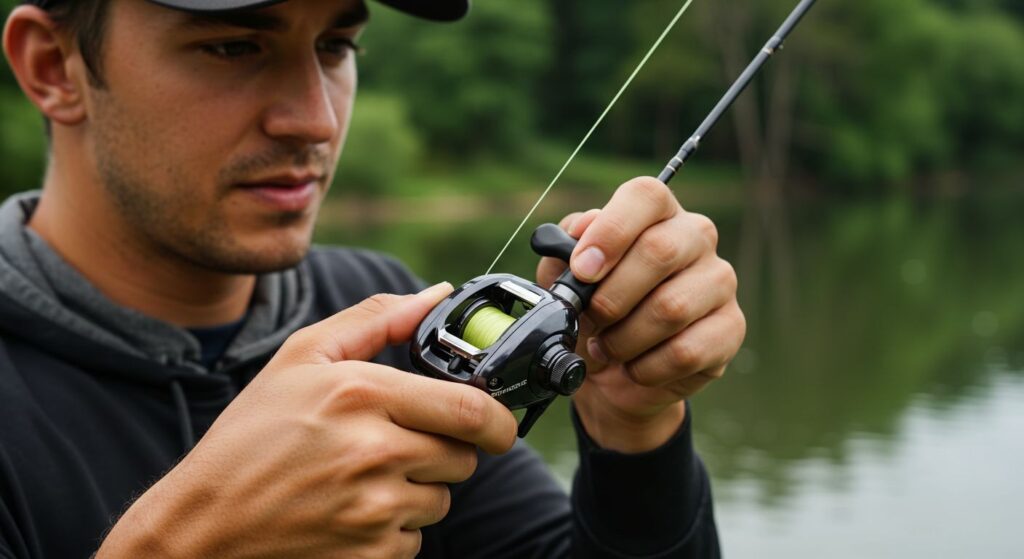
Many anglers make the mistake of not manually setting the bail on spinning reels:
- Using the reel handle to click the bail closed after casting often causes the loose line to wrap around the reel
- Unless using a heavy weight that naturally takes up slack, manually set the bail with your hand
This simple habit will eliminate a surprising number of tangles and frustrations.
Troubleshooting Spooling Problems
Fixing Line Twists
If you discover a line twist after spooling:
- Remove the line from the spool
- Rewind it with the twist facing the opposite direction
- Check for line twists again before fishing
Alternatively, tie the line to something far away (like a fence post), let all the line out as you walk away, then keep the line tight as you reel it back in.
I’ve also had success tying on a crankbait and fishing with it, casting as far as possible. The tension from the lure and water resistance will help keep the line tight and remove twists.
Addressing Loose Line Issues
To fix a loose line on your spool:
- Apply light tension between your rod and hand when retrieving
- Use just enough pressure to keep the line tight on the spool
- Apply this technique especially when using light lures or when there’s minimal tension on the line
The difference this makes in casting distance and reducing backlashes is remarkable—it’s one of those small adjustments with outsized benefits.
Spooling Different Line Types

Monofilament: The Classic Choice
Monofilament’s memory makes proper spooling crucial. Its tendency to retain the curve from its original spool means orientation matters enormously.
Fluorocarbon: The Invisible Advantage
Fluorocarbon shares many properties with mono, including memory, but it’s typically stiffer. When spooling fluorocarbon, I apply slightly more tension to ensure tight wraps.
Braided Line: Strength in Complexity
Spooling a fishing reel with braid requires special attention. Unlike mono and fluoro, braid has no memory but can slip on the spool. I always recommend starting with a mono backing when spooling with braid to prevent this slippage.
The key with braid is consistent but not excessive tension—too much and you’ll cut into lower layers, too little and you’ll create loose spots that cause casting problems.
Conclusion: The Foundation of Successful Fishing
Proper reel spooling is an essential skill for every angler. By understanding the specific requirements of your reel type, using the correct techniques to attach and wind line, and maintaining proper tension throughout the process, you can prevent frustrating issues like line twist and improper fill levels.
Taking the time to spool your reel correctly will result in better casting performance, fewer tangles, and ultimately a more enjoyable fishing experience. Remember that different line types have different characteristics and may require slight variations in the spooling process.
Regular practice and attention to detail will help you master this fundamental fishing skill, setting the foundation for success on the water. It’s not the most glamorous aspect of fishing, but it might be the most important.
FAQ: Mastering the Art of Reel Spooling
How often should I re-spool my fishing reel?
I recommend re-spooling spinning reels with monofilament or fluorocarbon every 3-4 months if you fish regularly. For braided line, you can often go 6-12 months before needing to replace it. Always inspect your line for frays, memory issues, or discoloration—these are signs it’s time for a fresh line, regardless of the timeline.
What’s the best knot for attaching line to a spinning reel spool?
For most situations, I prefer the arbor knot for its simplicity and reliability. The uni-knot is another excellent option. When spooling a fishing reel with braid, I recommend using a mono backing with an Alberto or FG knot to connect the two lines—this prevents the braid from slipping on the spool.
How much line should I put on my reel?
Fill your reel to approximately 1/8th of an inch from the edge of the spool for optimal performance. Overfilling causes loose lines and knots, while underfilling significantly reduces casting distance. When in doubt, slightly underfilled is better than overfilled.
Do I need a fishing reel spooling tool?
While not necessary, a fishing reel spooling device makes the process significantly easier and more consistent. These tools help maintain proper tension while spooling, resulting in tighter, more uniform line wraps. For about $15-20, it’s one of the best investments you can make in your fishing success.
How do I prevent line twist when spooling a spinning reel?
The key is ensuring proper line orientation. Place your line spool flat with the label up, feed the line through your guides, and attach it to the reel. After a few cranks, check for twists. If you see them, flip the spool over and try again. Always maintain consistent tension while spooling to prevent loose spots that lead to twists.

